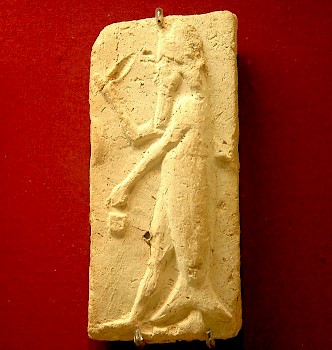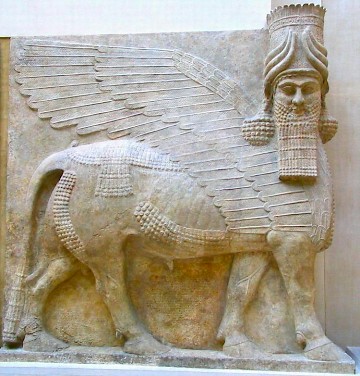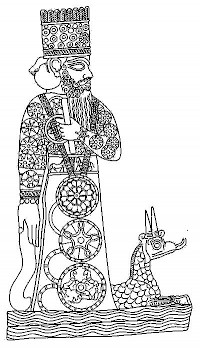Berossus on the Creation
The first book of Berossus' Babylonian history begins with a description of the creation of the world and humankind, based on the epic Enûma êliš, and includes the story of Oannes, who taught wisdom to man, and a Babylonian bestiary. Unfortunately, Berossus' own account is lost, but it was summarized in an Armenian translation of the Chronicon by the Christian author Eusebius. The text was translated by Gerald Verbrugghe and John Wickersham.

Berossus reports in the first book of his Babylonian history that he was a contemporary of Alexander, the son of Philip, and that many public records, which covered a period of over 150,000 years ago about the history of the sky and the sea, of creation, and of the kings and of their deeds, had been preserved with care.
First he says that the land of the Babylonians lies between the Tigris and the Euphrates. It produces wild barley, chickpea, and sesame, and even, in its marshlands, edible roots, called gongai. These roots are the equal of barley in nutrition. The land also produces dates, apples, and all sorts of other fruit, as well as fish and birds, field birds as well as waterfowl.
There are also in the land of the Babylonians waterless and infertile regions near Arabia, while lying opposite Arabia there are hilly and fertile areas. In Babylonia there was a large number of people of different ethnic origins who had settled Chaldaea. They lived without discipline and order, just like animals.
In the very first year there appeared from the Red Seanote in an area bordering on Babylonia a frightening monster, named Oannes [...]. It had the whole body of a fish, but underneath and attached to the head of the fish there was another head, human, and joined to the tail of the fish, feet, like those of a man, and it had a human voice. Its form has been preserved in sculpture to this day.
Berossus says that this monster spent its days with men, never eating anything, but teaching men the skills necessary for writing and for doing mathematics and for all sorts of knowledge: how to build cities, found temples, and make laws. It taught men how to determine borders and divide land, also how to plant seeds and then to harvest their fruits and vegetables. In short, it taught men all those things conducive to a settled and civilized life. Since that time nothing further has been discovered. At the end of the day, this monster Oannes went back to the sea and spent the night. It was amphibious, able to live on land and in the sea.
Later other monsters similar to Oannes appeared, about whom Berossus gave more information in his writings on the kings. Berossus says about Oannes that it had written as follows about the creating and government of the world and had given these explanations to man.

There was, he says, a time when the universe was only darkness and water, and in it there were wondrous beings with peculiar forms who were able to engender other living beings. For men with two wings were born, as were other with four wings and two faces. Some of these had one body but two heads, male and female, and two sets of sexual organs, male and female. Further, there were other men with the legs of goats and the horns of goats on their heads. Yet others had horses' feet, and others had the body of a horse for their lower extremities and human bodies for their upper body, which are the forms of hippo-centaurs.
Bulls were engendered with human heads, as were dogs with four bodies, who had fish tails on their hindquarters. There were also horses with dogs' heads, men and other creatures with the heads and bodies of horses, men with tails of fish, and all sorts of creatures who had the forms of all sorts of animals. In addition, there were fish, snakes, crawling things, and many other amazing creatures that had the appearance of two different animals combined. Their images are preserved one next to the other in the temple of Bêl [Esagila].
Over all these a woman had control, named Omorka, who in Babylonian is named Thalatth [Tiamat], but in Greek her name is translated as Thalassa [Sea] or, with the same value of the letters in the name, Selene [Moon].

While the world was in this state, Bêl rose up against that woman and cut her in half. Out of the first half he made the earth and out of the second the heavens. The animals who were in her he destroyed. All this, Berossus says, is an allegorical explanation. For when all was water and only monsters were in it, the god cut off his own head, and the other gods mixed the flood of blood with earth and created men. Because of this men have reason and share in the gods' wisdom.
But Bêl, whose name is translated into Greek as Zeus, cut through the darkness and separated the sky and the earth from one another and established order in the universe. The monsters could not endure the strength of the light and were destroyed. Bêl, however, as he saw an empty and barren region, gave an order to one of the gods to cut off his own head and mix earth with the flowing blood and to create men and the animals that could breathe the air.
Bel created the stars and the sun and the moon and the five planets. All this [...] Berossus reported in his first book.